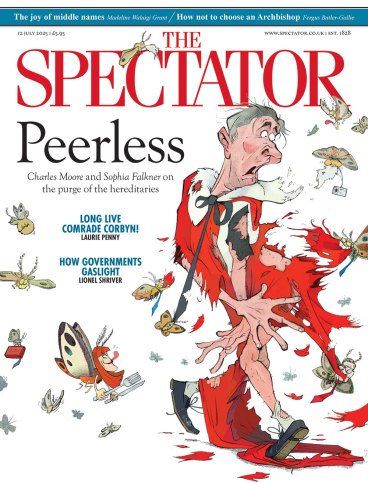
Evita, directed by Jamie Lloyd, is a catwalk version of the Andrew Lloyd Webber musical. The actors perform on the steps of a football stadium where they race through an effortful series of dance routines accompanied by flashy lights and thumping tunes. It’s more a drama-school showcase than an epic human tragedy. There are no interiors, no furnishings and no props – not even a suitcase for ‘Another Suitcase in Another Hall’.
Rachel Zegler plays the lead in black pants and a bra from M&S. In Act Two, she changes into a new bra and pants. White this time, with silvery spangles. She looks like a majorette. Why no proper clothing? Evita is a complex character who starts as a penniless street hustler and turns into a seasoned stateswoman manipulating the media from a presidential palace. She needs decent costumes to support and explain this transformation. Zegler struts about in her high street undies, leering and pouting provocatively but she can offer no warmth or tenderness. She’s the baddie here.
The narrator, Che (Diego Andres Rodriguez), looks like a jobless cocktail waiter. Juan Peron (James Olivas) seems uncomfortable in his Primark suit and tie. He has the truculent air of a convicted mugger at a parole hearing.
Zegler sings ‘Don’t Cry for Me, Argentina’ on a balcony outside the theatre for the benefit of a camera crew and a crowd of random Londoners. This is relayed to a monitor on stage. An odd decision. The punters have to watch a video of a performance that is being offered to passers-by for free. Some ticketholders may want their money back.
Intimate Apparel is a genteel story about a pleasant chatty woman, Esther Mills, who lives in New York in 1905. She’s a strange character for a melodrama because her life is full of delights. She loves her work as a seamstress and she receives lavish praise for her skills. She passes her time paying social calls to an array of amusing and civilised friends. Her wealthy client, Mrs Van Buren, treats her as an equal and asks if she enjoys opera and supports the suffragettes.
She’s attracted to a handsome Jewish tailor who emigrated from his native Romania but forgot to bring his fiancée with him for some reason. He shares cups of tea with Esther and they discuss the competing merits of taffeta, silk and lace. A romance is hinted at.
It’s more a drama-school showcase than an epic human tragedy
After a long day of gossip, Esther visits Mayme, a sexy nightclub pianist, who drinks gin and makes cryptic remarks about her profession. ‘A gentle touch is gold in any country,’ she says. At night Esther returns home and enjoys the affectionate teasing of her wise, twinkly landlady who asks if she has a suitor. Sure enough, Esther is being courted by George Armstrong, an educated bachelor with a steady job in Central America. He’s digging the Panama canal. It’s unclear how he and Esther met but he writes her long, erudite letters full of amorous implications. George is perhaps the most high-minded navvy ever to pick up a shovel. ‘I stood thigh-deep in crimson petals,’ he writes, after felling an exotic tree. Esther sends him envelopes containing bits of silk and cotton which strike George as rather puzzling. They’re bound to puzzle the audience too. The explanation is that the author, Lynn Nottage, links all her characters by means of fabrics and garments. Hence the show’s title.
It feels like a morality tale for schoolgirls written by a nun
This clumsy device gets more unwieldly as the play grinds forward. When Esther marries George, she surprises him with a smoking jacket made from Japanese silk. This matches the play’s formula, of course. The garment happens to be too small for George’s strapping frame but never mind. It’s crucial to the plot. The pace picks up in the second half when George decides to buy 12 horses and open a stud farm while Esther fights off a lesbian attack from Mrs Van Buren. From here, the story ought to intensify and the characters should grapple with life-and-death decisions but instead the author de-escalates the tension and settles for a banal, soppy conclusion. It feels like a morality tale for schoolgirls written by a nun. And that’s not good. Play-goers don’t want to see characters having an easy time. You might as well pay to watch people sunbathing.
Lynette Linton directs the show with energy and panache. And the actors do their best to bring life to their banal, well-mannered characters. For some reason, the set is a depressingly grimy structure which resembles a derelict warehouse that even the rats have abandoned. And it hardly suits the frivolous mood of the piece. Just ignore it. Instead enjoy the plush, beautifully embroidered costumes and the exceptional hairstyles and wigs arranged by Cynthia De La Rosa. If there were a Nobel prize for hairdos this show would win.









Comments